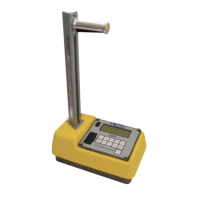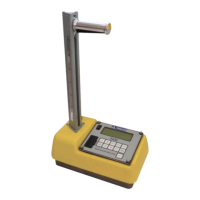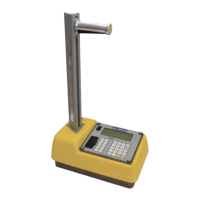TROUBLESHOOTING
GAUGE FAILS STANDARD COUNTS
✓
Ensure that the source rod opening on the gauge bottom is
completely closed or covered by the tungsten sliding block. If
any opening is visible, the sliding block should be cleaned as
described later in this chapter. If the sliding block still does not
close completely, contact the nearest Troxler Service Center.
NO DENSITY READINGS
✓
The most likely reason for no density readings is an electronic
problem, such as a failure of the detector preamplifier.
However, as a precaution, ensure that the tip of the source rod is
intact and undamaged (that is, ensure that the source is not
missing). Use a radiation survey meter to check the radiation
levels on contact with the surface of the gauge base (without
extending the source rod). A maximum reading of 10-20
mrem/hr is normal, and indicates the source is present.
However, if the maximum reading is less than 1 mrem/hr or if a
survey meter is not available, perform a visual inspection of the
source rod tip as follows to confirm its integrity:
1.
Extend the source rod just far enough to see the source rod
tip. The tip should appear flat to slightly rounded and
smooth.
2.
Stay at least three feet away from the tip of the unshielded
source rod and complete the inspection as quickly as
possible to minimize exposure (the dose rate at three feet
from the unshielded source is about 2.7 mrem/hr).
If the visual inspection indicates that the source rod tip is
broken off (source is missing):
1.
Immediately contact your Radiation Safety Officer (RSO).
2.
Initiate a search for the source starting at the location where
the gauge was last used.
C-2

